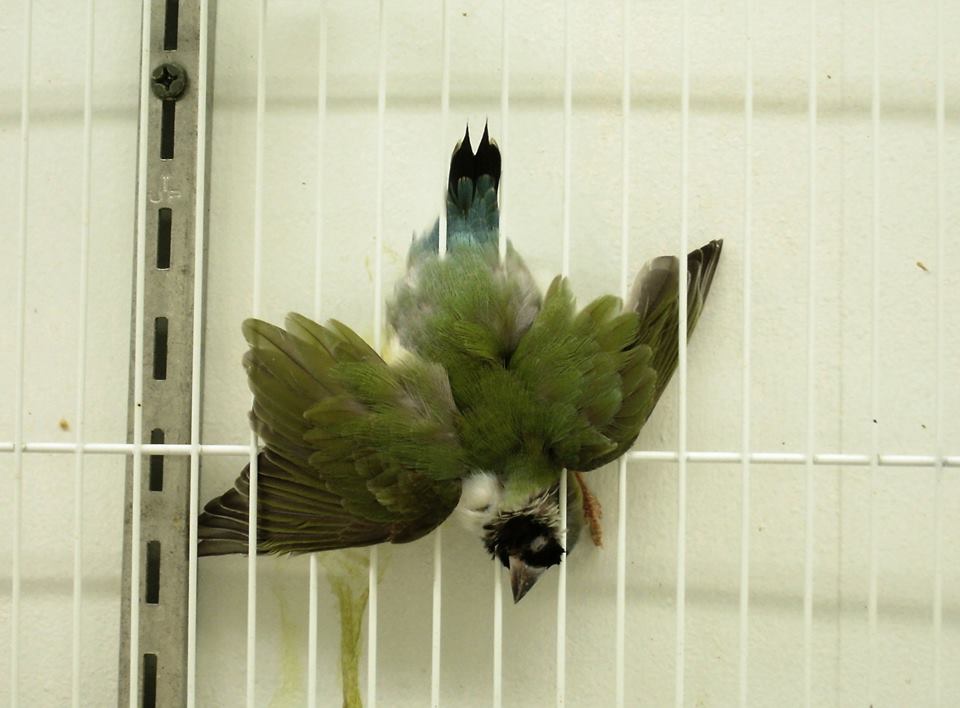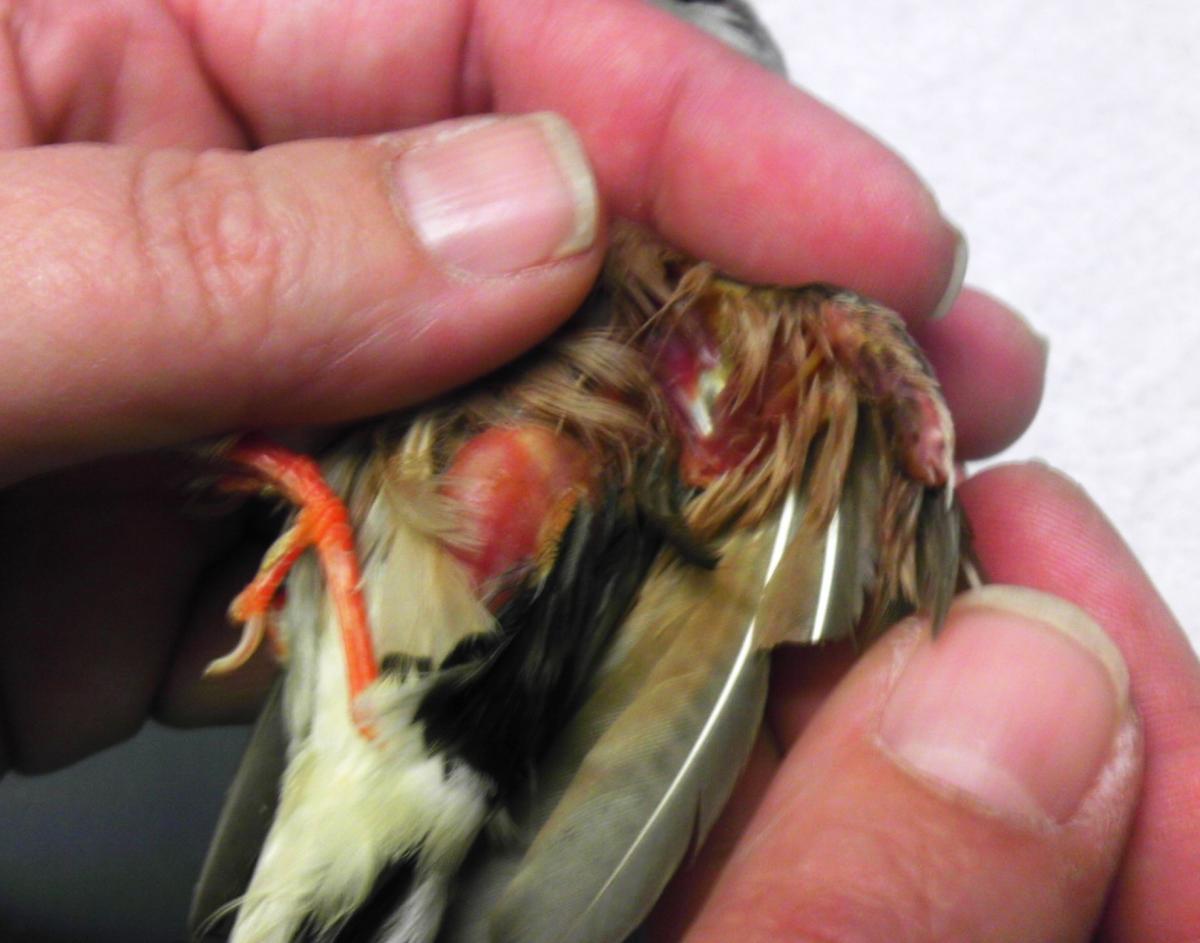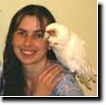Never Underestimate the Dangers in Your Own Aviary!
Kristen Reeves, Meadowlark Farms Avian Supply, Inc.
Most of us would like to think our aviary is a safe place for our birds. We do everything we can to keep them happy, healthy, and safe from dangers. But some of the most common items in the bird room can actually be a huge danger, especially to young birds. Below are just a few of those dangers.
CAGES:
 This girl had night frights and somehow got caught in the cage bars.
This girl had night frights and somehow got caught in the cage bars.
It's always traumatic to find that one of your birds has fallen prey to tragedy. To this day I have no idea how she got herself in this spot. She was on the inside of the cage and somehow got herself stuck with wings, rump & tail on the outside of the cage. Perhaps she was chasing a spider on the wall, or perhaps she flew into the bars accidentally. I will never know.
 Night frights caused this Shafttail to get caught in the cage bars. He seriously battered himself.Wings may get caught as well. A bird caught in the cage bars will attempt to free itself and will often thrash around until it is a bloody mess. A leg band caught in the bars can cause breaks which may or may not heal and that break, if compound, can bleed heavily resulting in the death of the bird. Once caught in the bars, a bird may find itself so stuck that even thrashing is impossible. It will still fight to free itself, and will exhaust itself until death unless found and freed. Being vigilant is imperative!
Night frights caused this Shafttail to get caught in the cage bars. He seriously battered himself.Wings may get caught as well. A bird caught in the cage bars will attempt to free itself and will often thrash around until it is a bloody mess. A leg band caught in the bars can cause breaks which may or may not heal and that break, if compound, can bleed heavily resulting in the death of the bird. Once caught in the bars, a bird may find itself so stuck that even thrashing is impossible. It will still fight to free itself, and will exhaust itself until death unless found and freed. Being vigilant is imperative!
MICE:
Something we don't hear about often, mice can be a severe issue in the bird room. In winter months, mice like to enter the house for warmth. What better place than the bird room to find heat, shelter, and FOOD. Seed and droppings on the floor of the aviary make the perfect dinner for mice. But once in the bird room, they are not opposed to having themselves a little mini-chicken for dinner either! Mice will attack sleeping birds and literally eat them. They can squeeze in any space they can get their head through. Young mice can get through even the 1/2" cage bars on most finch cages. Larger mice can chew through outside hang nest boxes and let themselves in. They WILL eat the eggs and young of nesting birds. In addition to being a predator threat, they also carry diseases that can kill our birds. Keeping them out of the bird room should always be a priority.MOTH TRAPS:
There are many types of moth traps, and many places to put them so that the birds can't get to them. But if you are like me and like to allow your birds to fly free in the bird room from time to time, it is important you secure those traps so the birds don't end up in them.
What was left of the trap after extracting 14 from it.I had a very scary incident once, where I'd allowed one of my hand-fed Gouldian chicks ("14") to fly free in the bird room, even when I wasn't watching him. He always went back to his cage at feeding and bedtime, so it never occurred to me he might get into trouble.
One night, after allowing him out for the day, I came into the bird room to feed & check on the birds before lights out. I realized 14 was nowhere to be found. I searched for HOURS in a panic, moving shelves and cages, seed bins, books - anything he could hide behind. Just as I was about to give up, I heard the smallest noise. I stood perfectly still and just listened...a small shuffling noise. I pin-pointed the noise and found 14 on the floor, pinned just behind the big glass-doored storage shelf. He was weak, but had done everything he could to let me know where he was.
And he was STUCK spread eagle in a moth trap. I screamed for Bryan to help, and we began the very tedious procedure of removing 14 from the trap. Every time we'd free part of his feathers from the sticky stuff, he'd move MORE of his feathers and stick some more. THINK GIRLY, THINK!!! Bryan suggested cutting the trap away, so we started to try that, but more feathers just kept sticking. I was thinking, "how do we get the sticky to not be sticky?" Ahhh - I grabbed a spoonful of diatomaceous earth and spread it over all the sticky areas left on the trap. That stopped more feathers from sticking. But at that point, 14 was so stuck that we had to literally cut his feathers to free him. He had struggled so much that he lost many feathers on his own, and his skin literally stuck to the trap. So we slowly added more DE under each individual feather as we extracted him. It was a nightmare.
14 in his hospital cage. Not a happy boy but thankfully alive!We finally freed him, but he was a mess. His wounds (raw skin and bleeding head) had to be cleaned and dressed. He then needed to be rehydrated. We syringed some QuikGel into him and set up a hospital cage. He eventually fully recovered and all of his feathers grew back, but it was hit or miss for a few days afterward. Lucky for him - and me - he survived and became a gorgeous yellow headed adult. But he was never let out to fly free without supervision again.
OTHER BIRDS:
 Sometimes other birds in your flock will badger or harass another bird. During breeding season especially, both cocks and hens may become aggressive - usually toward other birds, but sometimes toward each other. Breeding hormones can sometimes make them crazy! The only way to prevent serious harm is to separate them.
Sometimes other birds in your flock will badger or harass another bird. During breeding season especially, both cocks and hens may become aggressive - usually toward other birds, but sometimes toward each other. Breeding hormones can sometimes make them crazy! The only way to prevent serious harm is to separate them.
In the case of this Shafttail cock, his mate was overly eager to mate. Apparently he was a little slow to figure that out, so she pecked at him until his beak was seriously damaged. As you can see, It took just over two months for him to recover from the injury.
It is very important to remain vigilant even when you think your pairs are well bonded and getting along. Sometimes, even with the most careful pairing, one personality is stronger than the other, allowing the stronger to overtake the lesser!
Injuries like this don't always heal well. The potential for infection is great. The injured bird should always be removed from the cage and healed before being allowed to breed again.
OTHER AVIARY ACCESSORIES:
A shop vac can be a hazard if you have fledgling chicks in a cage. I use my shop vac to suck up stray nesting materials and clean up seed hulls that collect against the wall where the cage touches it. I HAVE accidentally sucked up chicks. Luckily, they were unharmed. The stress of such a ride can kill the chick or cause injuries. Care should be used when using a vacuum cleaner of any kind in the bird room.
I've learned my lesson from these few dangers and hope to prevent further injuries or death by paying close attention not only to the birds, but to the room itself.
- No large open water containers.
- No escape routes from the cages.
- No moth traps within reach of the birds if they are out.
- Watch closely for signs of pests, predators and parasites.
- Food & water left on top of highest cage in case of escapeesFood & water always left in an open place up high in case of escapees.
- Pesticides and supplements locked up in the cabinet with the doors secured.
- And the elimination of any hiding places the birds may creep into if they escape.
Hopefully I won't find any more issues - but my eyes are always open now! Keep your eyes peeled too!





